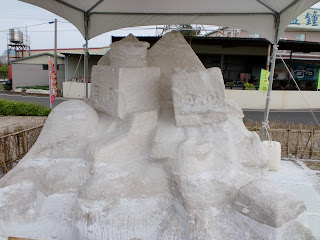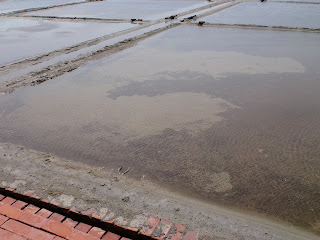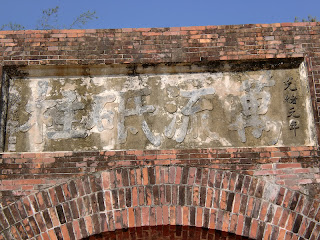I'll get to it eventually, but I want to write about things in order, so I'm writing about this trip I took to "Cigu Salt Mountain", "The Salt Museum", and "Eternal Golden Fortress" instead.
此の前の土曜日の話だ。知り合いは皆別のところに行ってしまったから、一人で台南の名所を回る観光バスで旅した。一日乗り放題券は120圓だ。(だいたい400日本円)其のバスで「七股塩山」と「塩博物館」と「億載金城」に行った。
First stop! Salt Mountain! It's what it sounds like. It's a big pile of salt. I heard that it used to be whiter. It's kind of a kitchy idea for a tourist attraction, but it is fun to visit because you get a nice view of the area. It's near the coast to the northwest of central Tainan.
The area has historically been a major salt producing area, and they still have salt fields, so going up on the salt pile let's you see them nicely.
「七股塩山」の辺り(台南の北西)は昔から海水で塩を作る地域だ。海が近くに有って、一年平均気温が高いから水の蒸発が速くて、塩作りに適している。此の塩山からの景色は案外面白い。塩田が広々としている風景は綺麗だ。
階段の写真。塩の粒(粒と言うかな?)がはっきり見える。
This is all salt. I'm not sure what they do when it rains...
Big poncho?
Salt fields stretch out into the distance. They actually look a lot like rice fields. They break up the salt fields into sections because it's easier to control the evaporation process if you have a series of small pools rather than one big one. (As for rice, I think they break the fields up to control the water level better.)
建物の向こう側は全部塩田だ。下に有る小さい電車は塩山と塩博物館を繋げる。
まだ水が沢山入っている塩田だ。
...and in case your ungrateful, bratty kids get bored of the salt, and the history of salt, you can take them down to the go-kart track and kill a couple minutes.
White dog, white salt.
なんか、日本の簡略された「塩」の字は元々のやつと全然違う。ここまで異なる字は少ないと思う。「皿」だけが一緒だ。
Brace yourselves. This next section is truly incredible. You thought you knew salt, but you didn't know anything. Salt is more wonderful than you would ever have believed. With the proper talent salt can even be:
This!
Or this!
Or these!
因みに、これらは中国の想像上の動物、「貔貅」(ひきゅうと読む、マンダリン語発音:ピショー)だ。ひの方は雄、きゅうの方は雌だ。ご縁のいい動物で、運を引き寄せる。又、俺のマンダリン語の苗字にも成っている。(マンダリン語では俺の元々の苗字と同じく、「ピ」の発音で始まるし、縁起のいいかなと思ったから選んだ。でもめっちゃ変な苗字に成っているから、皆は「なんで選んだの?」とか「難しい字だなぁ」とか言う。まあ、いい。其のお陰で俺の苗字を忘れる人は居ないと思う。)
To get the water from one salt field to another, higher one, people used to use these devices. As you can see, it's powered by one's feet, so it must have been awful out in the blazing sun. They used them until surprisingly recently. There were some photos in the Salt Museum from the 50's, with women wearing long, flower pattern dresses like women wore in the 50's while they worked these machines. These were later replaced by windmills and then by diesel or electric motors.
塩を運んだ汽車だ。日本製でもある。日本時代に日本帝国は積極的に七股の塩業を勧めた。
They used to have small, narrow gauge railways that transported the salt from the Cigu area to the main train line down the west coast of Taiwan.
I don't really have any photos from inside the salt museum, but this statue is just outside it. It's the mascot characters of the museum.
And here they are showing us to the toilet! What's the male one up to? I don't know if I like that sly look on his face...
これも以上のやつと同じく、塩博物館の外に有った。博物館はとても良かった。単に、中国語しか書いていないので、日本人なら、チンプンカンプンしか分からない。他の国の人は展示物を見るしか無い。塩田の歴史とかの展示が有った。
Salt fields out in back of the museum.
There was nowhere high enough for me to get a good photo, but someone has arranged this field so that it reads:
福
BLESSING フク
You can see the "ng" at the end of "blessing" in this photo.
「福」の漢字の「田」も見えるね。
Mostly done salt field.
盗られちゃった!俺の塩は!しかも、なんでわざとちょっと残した!?
猫連れの娘。
A young girl and her very patient, very cooperative cat.
After visiting the museum, then missing the bus, then visiting the salt fields next to the museum, then waiting in the hot sun for half an hour so that I definitely wouldn't miss the next bus, then taking the bus down back to Tainan, I visited "Eternal Golden Fortress". It's an impressively named fort that was built by the Qing to help repel naval invasions of the Tainan coast. It was built in 1874, near the end of the Qing control of Taiwan, around the time when they finally started to care about the island a little bit. It saw some action in the war with Japan, but then the Japanese took over Taiwan and the fort was disarmed.
これは「億載金城」だ。清朝が台湾支配の終わり頃に作った砦だ。(1874年に)日清戦争の時はちょっと使われたが、日本支配時代には砦として役が無く成った。名前に「金」が入っているけど、金を全く見掛けていない。銀閣寺みたいなもん。
現在は堀を舟で回る事が出来る。
玄関
If you were a soldier in Qing Era Taiwan, you might have been training in the blazing sun in this courtyard.
The fort is mostly a square, but at each corner of the square, it has a section that sticks out like this.
ラブラブのカップル。俺は邪魔して彼等が立っているところまで行って写真を撮った。ご免!
邪魔者の写真。
I just missed these guys. As I was walking through the front entrance of the fort, I heard some loud banging noises. While I was walking around the wall, I saw these guys walking to the entrance. I assume they must have been firing off some Qing Era guns at one corner of the fort.
清朝時代に砦に有った大砲は外国から輸入された物とたしか書いて有ったと思う。イギリス製だったっけ?
I saw some people doing hilarious "Woah! I'm standing in front of the cannon! I'm gonna get shot!" photos as I walked around the wall. Watching them take the photos was hilarious for me too until I saw it for the 8th time. I understand though. I probably would have done the same if I had been with other people.
花の世話をするおじさん。因みに、「おじさん」と「おばさん」は台湾でも通じるらしい。日本語の影響で、“歐吉桑”と“歐巴桑”が言葉に成っている。
玄関の内側。
Shot of the entrance from inside.
Ducks!
俺は個人的に砦とかお城とかグスクとか大好きだから、大南門と以上の億載金城は今まで見た名所の大お気に入りだ。こんなのがあっちこっち残っている台南は本当に台湾の貴重な都市だ。
Next up: More Japanese Era buildings in Tainan, and, eventually, Sun Moon Lake.





























































これだけあちこち行って写真を撮影するなら、台湾の旅行ガイドを作るつもりで資料を集めたり、いい写真を撮るようにしてみたら?英語圏の旅行会社とか、ガイドブックを出している出版社に売れるかもしれないよ。もしかしたら、日本語でもいけるかも。
ReplyDeleteもし、一眼レフのデジカメを持っているなら、なんとなく撮るんじゃなくて、構図を考えて撮影するといい写真が撮れるよ。それから、人物を撮影するときは 構図とシャッターチャンスを考えましょう。一眼レフで撮ると、写真を撮るのがとっても楽しくなるよ。ーて
確かに、もっといいカメラが最近ちょっと欲しく成って来たが、、、
Deleteちょっと無理しても、一眼レフ、買った方がいい。
ReplyDelete世の中の見え方が変わります。